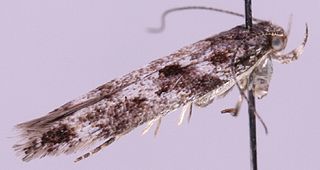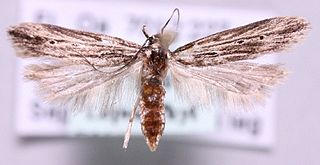Ephysteris is a genus of the twirler moth family (Gelechiidae). Among these, it is assigned to tribe Gnorimoschemini of the subfamily Gelechiinae. Even though it is a rather diverse and widespread group, most of these small and inconspicuous moths were overlooked by scientists until the early 20th century. Almost 90 species are known today but new ones are still being discovered.

Dactylotula kinkerella is a moth of the family Gelechiidae. It is found from Sweden to the Pyrenees and Alps, and from the Netherlands to Ukraine. It is also found in Croatia and Russia. The habitat consists of sandy areas.

Caryocolum schleichi is a moth of the family Gelechiidae. It is found in central, most of western and parts of eastern Europe, Morocco, Turkey, Syria, Afghanistan and Mongolia.

Caryocolum junctella is a moth of the family Gelechiidae. It is found from most of Europe east to China and Japan.

Caryocolum petrophila is a moth of the family Gelechiidae. It is found in France, Italy, Austria, Switzerland, Estonia, Scandinavia, North Macedonia and Russia. It is also found in Turkey.

Caryocolum kroesmanniella is a moth of the family Gelechiidae. It is found from Fennoscandia to the Pyrenees, Alps and Romania and from Great Britain to southern Russia. The habitat consists of open woodland.
Caryocolum repentis is a moth of the family Gelechiidae. It is found in Spain, France, Germany, Austria, Switzerland, Italy, Slovenia and Russia.

Chionodes distinctella, the eastern groundling, is a moth of the family Gelechiidae. It is found in almost all of Europe, as well as most of Russia, Kazakhstan, Central Asia and North Africa. The habitat consists of dry, rocky heath and meadows and the verges and rough pastures.

Chionodes fumatella, the downland groundling, is a moth of the family Gelechiidae. It is found in almost all of Europe. Outside of Europe, it is found in Turkey, the Caucasus, Mongolia and from Siberia to the Russian Far East.

Chionodes tragicella is a moth of the family Gelechiidae. It is found in the Netherlands, Belgium, France, Germany, Denmark, Switzerland, Austria, Slovenia, Italy, Hungary, Slovakia, the Czech Republic, Poland, Sweden, Finland and Russia. Outside of Europe, it has been reported from Transbaikal and Tuva.
Ephysteris tenuisaccus is a moth of the family Gelechiidae. It is found in Russia and on Cyprus. The habitat consists of chalk steppe.

Monochroa palustrellus, the wainscot neb, is a moth of the family Gelechiidae. It is found in from western, central and northern Europe to the Ural Mountains and southern Siberia. The habitat consists of waste ground, dry pastures and sand-dunes.

Eulamprotes superbella is a species of moth in the family Gelechiidae. It is widely distributed in Europe, from the Alps to northern Europe. Outside Europe it is found in Turkey, the Caucasus, Siberia (Transbaikalia) and Mongolia. The wingspan is 6–7 mm. Adults are on wing from April to June. The larvae feed on Thymus serpyllum and Gnaphalium species.

Exoteleia dodecella, the pine bud moth, is a moth of the family Gelechiidae. It is widely distributed from western Europe to Siberia. It is an introduced species in North America.

Gelechia rhombella, the apple groundling, is a moth of the family Gelechiidae. It is found in Europe, the Caucasus, Transcaucasia, southern Siberia, the Russian Far East, Korea and China.

Gelechia turpella, the grand groundling, is a moth of the family Gelechiidae. It is widely distributed in Europe. Outside of Europe, it is found from the Caucasus to Siberia and the Russian Far East. The habitat consists of woodlands and parks.

Psoricoptera gibbosella, the humped crest, is a moth of the family Gelechiidae. It is widely distributed in Europe. Outside of Europe, it is found in Turkey, North Africa, China, Japan, Korea, Siberia and the Russian Far East. The habitat consists of mature woodlands.
Prolita solutella is a moth of the family Gelechiidae. It is widely distributed throughout Europe, east to the Ural mountains. It is also found in Turkey. The habitat consists of dry pastures and dry heathland.

Gnorimoschema streliciella is a moth of the family Gelechiidae. It is locally distributed from central and northern Europe to the southern Ural Mountains and from Siberia and Mongolia to the Amur region and northern China.
Ephysteris deserticolella is a moth of the family Gelechiidae. It is found on Cyprus and in Ukraine, the south-eastern part of the European Russia, Turkey, Iran and Afghanistan.














